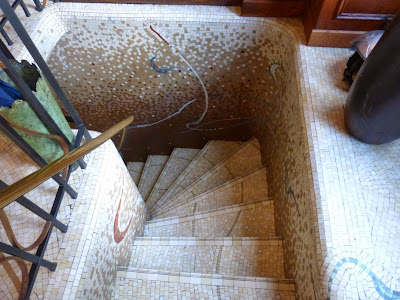We had visited several of Paris' great parks over the preceding weeks and thought we might finish our stay with the largest of these, the Bois de Vincennes, on the edge of the city. Vincennes, now a suburb that appears as densely populated as the rest of Paris, is the home also of the Chateau de Vincennes, another royal chateau, one of the greatest of still-intact Medieval fortresses, featuring the highest
donjon in all of Europe. Alas, we spent most of our time at the chateau and at the royal chapel, making only a brief excursion to the nearby Parc Floral. We'll have to see the rest of the Bois de Vincennes itself next time.
 |
| Main exterior wall and entry tower--17th century; the chateau is within these walls |
 |
| Another side of the wall--about a kilometer all around |
 |
| The entry tower, impressive enough by itself if not Medieval |
 |
| Plan of the chateau |
 |
| Helpful model; the Medieval chateau is the big walled structure center right |
 |
| Thus; as I said, donjon is the tallest in Europe |
 |
| Vertically |
 |
| Along the battlements |
 |
The Chateau de Vincennes has the usual royal chateau history...first a royal hunting
lodge, then a royal fortress, then a prison, then a factory, then a warehouse...now a
historical site and military museum...some of the 18th century prisoners were
artistically-gifted |
 |
| King's private personal chapel |
 |
| Vaulting in one of the towers |
 |
| Up closer on one of the capitals |
 |
| Prisoner? empoyee? tourist? |
 |
| Architectural ornament |
 |
During the centuries of royal residence and comings and
goings, the interior was entirely paneled; little remains but
nails that held the paneling to the stone walls |
 |
The Chateau is the site of much history: three French kings died there, and one
English king, Henry V (who was sieging and pressing his claim to be king of
France too); as a prison, it held the Marquis de Sade (I'm standing in his cell),
Enlightenment types Mirabeau and Cordorcet; Louis XVIII was executed there;
so was Mata Hari; and of course Germans killed people here as everywhere else |
 |
One of the Marquis de Sade's letters to his wife, written at Chateau de Vincennes:
"please forgive me, honey..." |
 |
| One of Condorcet's books, ditto |
 |
Fascinating place...probably not high on most tourists' must-see
lists, but very easy to get to...at the eastern end of Metro line #1 |
































































